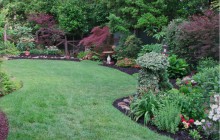Reduce Lawn Size
Purpose Improve management of stormwater, reduce sources of water pollution, and provide habitat for wildlife by replacing some lawn areas with New Jersey native plant species. The benefits of replacing lawn with native shrub borders, perennial flower beds, rain gardens, and other mixed native plantings include: Standard Actions NOTE: By combining this Action with 7A […]
Step 6: Reduce Lawn Size

Purpose
Improve management of stormwater, reduce sources of water pollution, and provide habitat for wildlife by replacing some lawn areas with New Jersey native plant species.
Why It’s Important
While turfgrass tolerates regular foot traffic, making it well-suited for recreational spaces, it is also more expensive and time-consuming to maintain, has a greater environmental burden, and is not as wildlife-friendly as other landscaping choices.
Replacing areas of lawn not needed for recreational activities with native vegetation protects the environment and reduces maintenance costs (e.g., fuel and labor for mowing). Beds of deep-rooted native plants are more effective than lawns at capturing and infiltrating stormwater, thus reducing the quantity of runoff and pollutants entering our waterways. Well-adapted to our local climate and soil conditions, native plants are low-maintenance, requiring little, if any, irrigation and fertilization.

The benefits of replacing lawn with native shrub borders, perennial flower beds, rain gardens, and other mixed native plantings include:
- Lower maintenance costs,
- More stormwater infiltrated on site,
- Less polluting lawn chemicals (fertilizers, herbicides, and pesticides) entering streams, rivers, lakes and the Barnegat Bay,
- Less air pollution from gas-powered lawn mowers,
- More habitat for birds, pollinators, and other local wildlife, and
- Enhanced aesthetics and biodiversity.
Standard Actions
NOTE: By combining this Action with 7A (see Step 7: Create Wildlife Habitat), you have an opportunity to complete two Standard Actions at the same time. Standard 6A can be satisfied jointly with Standard 7A , i.e. wildlife habitat can be created on the same areas where lawn is replaced with native plants.
6A: Identify at least one potential site for replacing lawn with native vegetation and develop a list NJ native plants appropriate for the site.

On a municipal property for which a base map has been prepared (see Step 1B), identify potential locations for replacement of turf with New Jersey native plant species. To maximize the infiltration of stormwater on-site, target lawn replacement in the following areas:
- Along property edges,
- Adjacent to impervious surfaces (such as roads, sidewalks, and driveways),
- In areas near roof downspouts, and
- Along streams, ponds, or other waterways.
Use the JFY Plant Database and other sources to search for NJ native plant species suitable for the soil, light, and other growing conditions at the potential habitat restoration site(s). Planting the right plant in the right place is critical for the success of any planting project. Before making any plant choices, get a soil test and collect as much information as possible about site conditions, including the following:
- Number of hours of direct sunlight during the growing season,
- Soil test results and soil conditions (soil type, pH, and moisture level),
- Direction of water flow during a rain storm,
- Location of any wet areas or drainage problems,
- Potential for wildlife damage (e.g., from deer or geese), and
- Potential for exposure to salt water or salt spray.
In addition to determining site conditions, decide on any other factors important for selecting the right native plants for your project (e.g., attracting certain types of wildlife).
Enter the information you have collected into the JFY Plant Database search filters to generate a list of appropriate native plant choices for your planting location. Be sure to include “Yes” for “Native Plants Only” in your filter choices.
What to submit for Action 6A: A base map showing the location(s) and approximate dimensions of the project area and a summary of the growing conditions there; a list of the search filter selections entered into the JFY Plant Database (including “Yes” for “Native Plants Only”); a list of NJ native plants, including scientific names, generated through your search on the JFY Plant Database; and a list any other resources you used to research appropriate NJ native plant species for the site.
6B: Identify potential no-mow zones on municipal property.
A no-mow zone is an option for areas where removing turf is not feasible. A no-mow zone allows native plants to naturally colonize the area over time. Planting or seeding the zone with some native species can help to jump-start the process. Stormwater basins and areas along streams, ponds, and other waterways are good candidates for no-mow zones, not only for reducing stormwater runoff but also for deterring access to upland areas by nuisance geese.

What to submit for Action 6B: A property base map showing the location and approximate dimensions of potential no-mow zones.

Cross-Connections with Sustainable Jersey Actions
Efficient Landscape Design
Green Grounds and Maintenance Policy
Resources
- Jersey-Friendly Yards: Step 6
- Jersey-Friendly Yards: Plant Database
- University of Maryland Extension: Lawn Alternatives
- Going Native: A Guide to Landscaping with Native Plants in the Barnegat Bay Watershed
- NJ Pinelands Commission: Native Pinelands Plants for the Landscape

